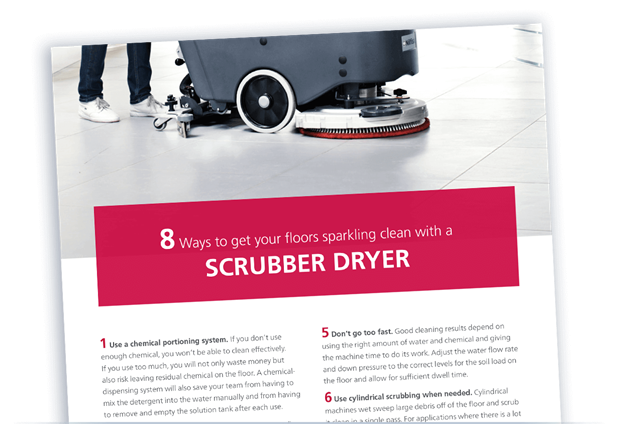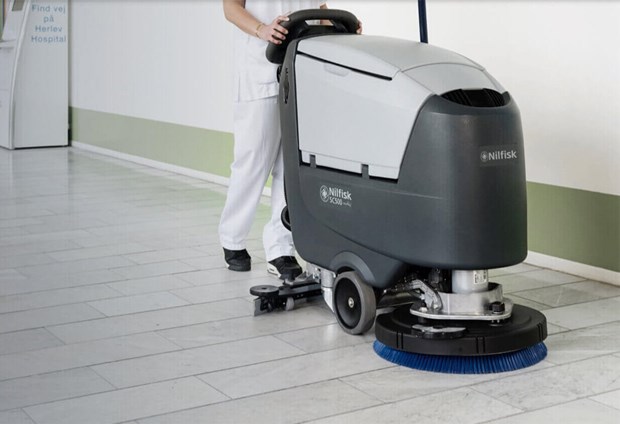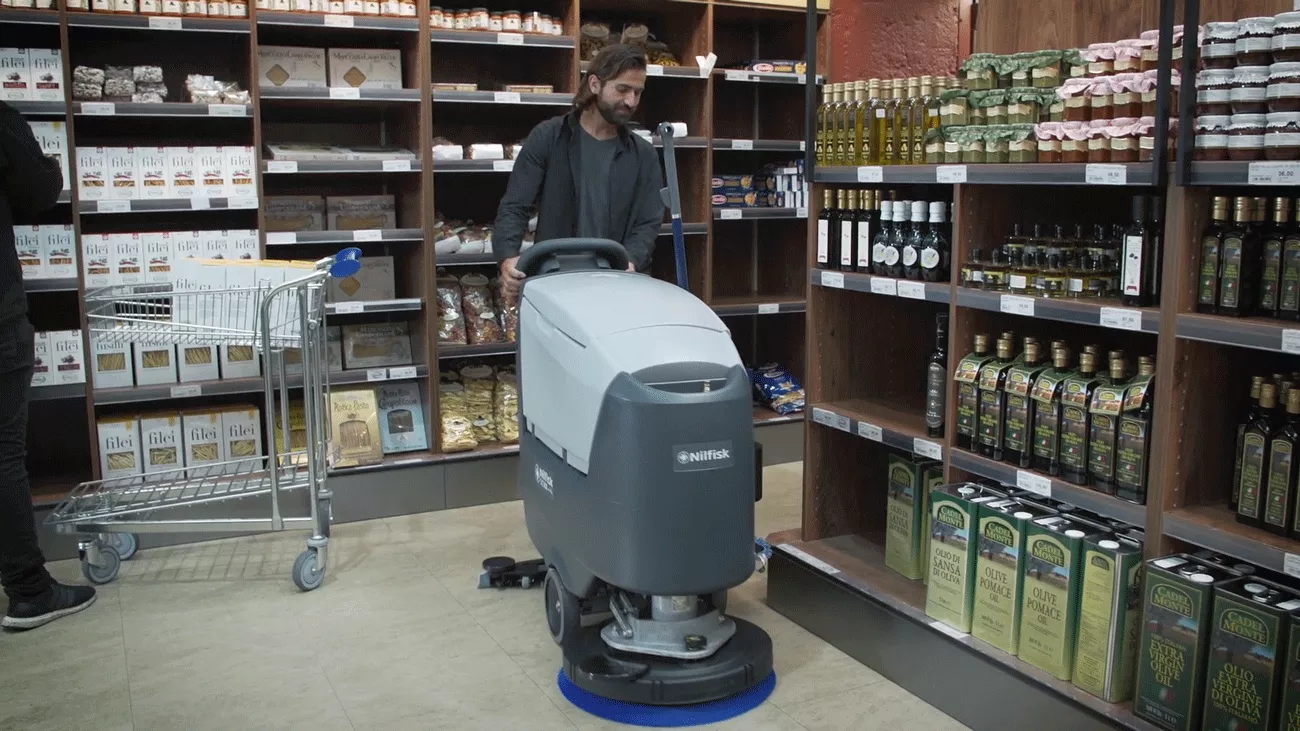The rapid spread of the COVID-19 around the world has brought hygiene practices into sharp focus. On a personal level, we are all being much more diligent about regularly washing and sanitizing our hands. Meanwhile, in hospitals, grocery stores, and other facilities that provide essential services, teams of cleaners are working overtime to clean and disinfect surfaces.
Even before the coronavirus outbreak, floor cleaning was critical for infection control. While it is unknown how long the virus that causes COVID-19 can live on surfaces, including floors, the World Health Organization estimates that it could be as long as a few days.
Floors are not as high-touch as many other surfaces (door handles, light switches, etc.), but contaminants on the floor can transfer to these other surfaces very easily. People can kick contaminants into the air with their shoes, germs can travel on carts and other equipment, and anything picked up off the floor can bring contaminants with it.
The fastest, most effective, and safest way to clean hard floors in commercial, institutional, and industrial facilities is with a scrubber dryer. This article briefly reviews why a scrubber dryer is the preferred method, presents best practices for using a scrubber dryer, and answers some common questions about cleaning to prevent the spread of COVID-19.
Why use a scrubber dryer?
When it comes to hard floor cleaning, the manual method (i.e., mopping) does not get the job done.
There are four primary advantages to using a scrubber dryer:
- Hygiene. Mop water is only clean the first time it is used. Every subsequent dip of the mop adds contaminants to the water. Scrubbing is the only way to guarantee that you put nothing but clean water and chemicals onto your floor.
- Effectiveness. Mopping does not remove contaminants; it just spreads them around. After measuring bacterial contamination on mops used in hospitals, a group of Canadian researchers concluded that mopping was equivalent to “the daily painting of hospital floors with thick suspensions of...organisms.” In contrast, scrubber dryers clean and extract dirt very effectively, ensuring that cleanliness standards are met.
- Safety. After mopping, the floor is wet, which increases the risk of slip and fall incidents. A scrubber dryer scrubs and dries in one pass so that the floor will not be slippery.
- Productivity. Even if mopping were a safe, effective way to clean, it would still not be a productive one. Scrubber dryers can clean many times faster than mops, freeing up cleaners’ time for other important tasks.
Best practices for cleaning with a scrubber dryer
Cleaning with a scrubber dryer is inherently safer and more effective than cleaning with a mop. As long as your team follows the recommended protocols for personal protection (e.g., wearing masks and gloves, washing hands frequently, avoiding touching face), using a scrubber dryer will not put increase their risk of contracting COVID-19.
These best practices will help you maximize the machine’s performance:
- Use a chemical-portioning system. If you do not use enough chemical, you will be unable to clean effectively. If you use too much, you will not only waste money but also risk leaving chemical residue on the floor. A chemical-portioning system will also save your team from having to mix the detergent into the water manually, and eliminate the need to remove and empty the solution tank after each use.
- Keep the machine clean and dry. You cannot clean a floor with dirty equipment. All parts of the machine, including all brushes and pads, should be thoroughly washed after use, and allowed to dry.
- Inspect the squeegees and blades regularly. If the squeegees are not kept in good condition, the machine will not be able to pick up contaminated water effectively. For more information about maintenance, read “Maximizing your scrubber’s life and performance.”
- Keep the recovery-tank lid open after use. This will allow the machine to dry, and eliminate odor-causing bacteria.
- Do not go too fast. Good cleaning results depend on using the right amount of water and chemical, and giving the machine time to do its work. Adjust the water-flow rate and pad pressure to the correct levels for the soil-load on the floor, and allow for sufficient dwell time.
- Use cylindrical scrubbing when needed. Cylindrical machines wet-sweep large debris off of the floor, and scrub it clean in a single pass. For applications where there is a lot of loose debris, a cylindrical machine can save considerable time because pre-sweeping is unnecessary.
- Use a pad containing diamonds or cubic zirconia. Pads containing microscopic diamonds or cubic zirconia provide excellent cleaning results for certain types of floors. In real-world tests, these pads have been shown to significantly decrease the amount of bacteria on flooring.
- Double-scrub as required. If the area is particularly dirty, double-scrubbing may be the only way to remove stubborn soils.
Professional floorcare helps maximize your cleaning standard
Free guide
Better hygiene through more effective floorcare
Deliver better scrubber-drying results with knowledge and advice from our experts.
Improve your knowledge of scrubber dryers with our new article, and boost your floorcare performance today with our Tips & Tricks guide.

COVID-19
Supporting the people who keep the world clean
See how we’re helping cleaning professionals deliver a better, safer hygienic standard around the world.

FAQ
Cleaning to prevent the spread of COVID-19
What chemicals should I use in the machine? Can I use bleach?
You should always follow the guidelines provided by your local authorities and make sure the detergent you use is approved for scrubber dryers.
We do not recommend using bleach because it may damage both the equipment and the floor.
Can I use a scrubber dryer to disinfect my floors?
No. Most disinfectants require a dwell time of up to 10 minutes, which is longer than the contact time during scrubbing. The job of the scrubber dryer is to clean the floor thoroughly so you can then disinfect as needed.
Can I use hot water in my scrubber dryer?
No. You should not put water hotter than 40°C into the tank. While the virus that causes COVID-19 is known to be sensitive to temperatures above 56°C, killing the virus via high temperature also requires an extended dwell time (at least 30 minutes).
Does a scrubber dryer need a HEPA filter to keep contaminants from re-entering the air via exhaust from the suction motor?
No. While HEPA filters keep contaminants contained during dry vacuuming, they aren’t necessary for wet applications because the particles bind with the water and are not exhausted back into the environment. Our scrubber dryers are widely used without HEPA filters in the cleanroom industry, which has strict requirements concerning the number of particles allowed in the air.
Nilfisk is here to support the cleaning teams that are working tirelessly to fight the spread of COVID-19. If you have any questions about cleaning during this time, please contact us at mail.com@nilfisk.com.



